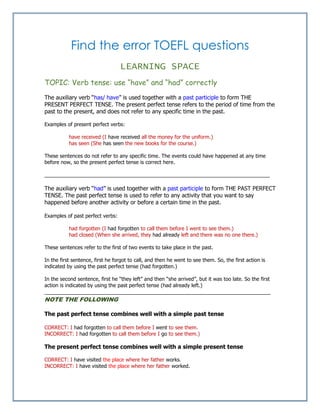Verb tense use have and had correctly
•
0 likes•446 views
The document discusses the proper use of the present perfect and past perfect verb tenses. The present perfect tense uses "have" or "has" with a past participle to refer to an action that began in the past and continues to the present without a specific time. The past perfect tense uses "had" with a past participle to refer to an action that occurred before another past action. It provides examples of each tense and notes they must be used correctly with other verb tenses, with the past perfect combining with a simple past tense and the present perfect with a simple present tense.
Report
Share
Report
Share
Download to read offline

More Related Content
What's hot
What's hot (20)
Verb tenses - How to distinguish different verb tenses

Verb tenses - How to distinguish different verb tenses
Viewers also liked
Viewers also liked (20)
English 100 error detection & correction for all exams by das sir(09038870684)

English 100 error detection & correction for all exams by das sir(09038870684)
Similar to Verb tense use have and had correctly
Similar to Verb tense use have and had correctly (20)
PresentandPastPerfect.JoselynSantana.English1.pptx

PresentandPastPerfect.JoselynSantana.English1.pptx
More from Melvin Duke
More from Melvin Duke (12)
Recently uploaded
GIÁO ÁN DẠY THÊM (KẾ HOẠCH BÀI BUỔI 2) - TIẾNG ANH 8 GLOBAL SUCCESS (2 CỘT) N...

GIÁO ÁN DẠY THÊM (KẾ HOẠCH BÀI BUỔI 2) - TIẾNG ANH 8 GLOBAL SUCCESS (2 CỘT) N...Nguyen Thanh Tu Collection
Operations Management - Book1.p - Dr. Abdulfatah A. Salem

Operations Management - Book1.p - Dr. Abdulfatah A. SalemArab Academy for Science, Technology and Maritime Transport
Research Methods in Psychology | Cambridge AS Level | Cambridge Assessment In...

Research Methods in Psychology | Cambridge AS Level | Cambridge Assessment In...Abhinav Gaur Kaptaan
Recently uploaded (20)
Keeping Your Information Safe with Centralized Security Services

Keeping Your Information Safe with Centralized Security Services
Basic phrases for greeting and assisting costumers

Basic phrases for greeting and assisting costumers
Basic Civil Engineering Notes of Chapter-6, Topic- Ecosystem, Biodiversity G...

Basic Civil Engineering Notes of Chapter-6, Topic- Ecosystem, Biodiversity G...
Instructions for Submissions thorugh G- Classroom.pptx

Instructions for Submissions thorugh G- Classroom.pptx
GIÁO ÁN DẠY THÊM (KẾ HOẠCH BÀI BUỔI 2) - TIẾNG ANH 8 GLOBAL SUCCESS (2 CỘT) N...

GIÁO ÁN DẠY THÊM (KẾ HOẠCH BÀI BUỔI 2) - TIẾNG ANH 8 GLOBAL SUCCESS (2 CỘT) N...
Telling Your Story_ Simple Steps to Build Your Nonprofit's Brand Webinar.pdf

Telling Your Story_ Simple Steps to Build Your Nonprofit's Brand Webinar.pdf
Operations Management - Book1.p - Dr. Abdulfatah A. Salem

Operations Management - Book1.p - Dr. Abdulfatah A. Salem
Research Methods in Psychology | Cambridge AS Level | Cambridge Assessment In...

Research Methods in Psychology | Cambridge AS Level | Cambridge Assessment In...
Jose-Rizal-and-Philippine-Nationalism-National-Symbol-2.pptx

Jose-Rizal-and-Philippine-Nationalism-National-Symbol-2.pptx
Industrial Training Report- AKTU Industrial Training Report

Industrial Training Report- AKTU Industrial Training Report
INU_CAPSTONEDESIGN_비밀번호486_업로드용 발표자료.pdf

INU_CAPSTONEDESIGN_비밀번호486_업로드용 발표자료.pdf
Danh sách HSG Bộ môn cấp trường - Cấp THPT.pdf

Danh sách HSG Bộ môn cấp trường - Cấp THPT.pdf
Verb tense use have and had correctly
- 1. Find the error TOEFL questions LEARNING SPACE TOPIC: Verb tense: use “have” and “had” correctly The auxiliary verb “has/ have” is used together with a past participle to form THE PRESENT PERFECT TENSE. The present perfect tense refers to the period of time from the past to the present, and does not refer to any specific time in the past. Examples of present perfect verbs: have received (I have received all the money for the uniform.) has seen (She has seen the new books for the course.) These sentences do not refer to any specific time. The events could have happened at any time before now, so the present perfect tense is correct here. _______________________________________________________________________________ The auxiliary verb “had” is used together with a past participle to form THE PAST PERFECT TENSE. The past perfect tense is used to refer to any activity that you want to say happened before another activity or before a certain time in the past. Examples of past perfect verbs: had forgotten (I had forgotten to call them before I went to see them.) had closed (When she arrived, they had already left and there was no one there.) These sentences refer to the first of two events to take place in the past. In the first sentence, first he forgot to call, and then he went to see them. So, the first action is indicated by using the past perfect tense (had forgotten.) In the second sentence, first he “they left” and then “she arrived”, but it was too late. So the first action is indicated by using the past perfect tense (had already left.) ________________________________________________________________________ NOTE THE FOLLOWING The past perfect tense combines well with a simple past tense CORRECT: I had forgotten to call them before I went to see them. INCORRECT: I had forgotten to call them before I go to see them.) The present perfect tense combines well with a simple present tense CORRECT: I have visited the place where her father works. INCORRECT: I have visited the place where her father worked.
